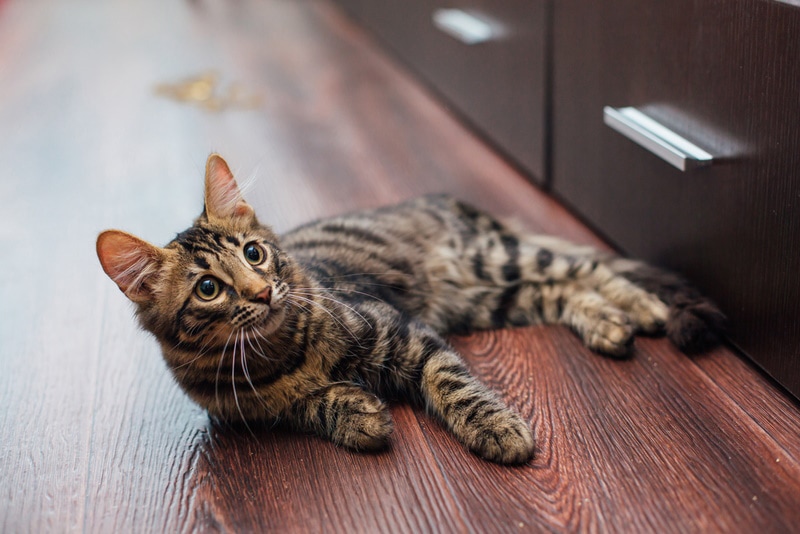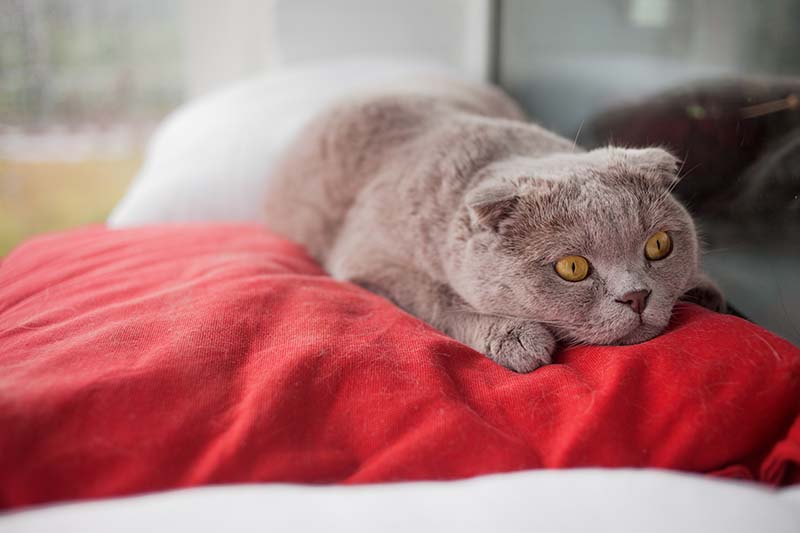Radial Nerve Paralysis in Cats: Signs, Causes & Treatment (Vet Answer)
Updated on

Click to Skip Ahead
Radial nerve paralysis in cats is a neurological condition affecting one (but sometimes both) of the front legs, often following an injury or traumatic event. When the radial nerve is damaged or severed, the cat’s ability to use the front leg becomes impaired. Some radial nerve injuries get better with time and appropriate treatment, but other more severe injuries result in permanent abnormalities in limb function.
This article will explore the radial nerve, as well as the signs and causes of radial nerve paralysis, and what can be done to treat this condition.
What Is the Radial Nerve?
Understanding radial nerve paralysis requires a basic understanding of some nerve anatomy. In cats, as in people, the central nervous system comprises the brain and spinal cord. Other nerves, often called peripheral nerves, branch off from the spinal cord to innervate the muscles and other organs. There is a large bundle of nerves branching from the spinal cord to the front legs; this is called the brachial plexus.
Emerging from the brachial plexus is the radial nerve. The radial nerve is the largest in the front leg of cats and is responsible for extending the elbow, wrist, and toes. It also provides sensation to the outside surface of some parts of the leg, allowing cats to feel with their leg.

What Is Radial Nerve Paralysis?
Radial nerve paralysis occurs when something disrupts nerve signals to muscles, resulting in the loss of voluntary movements. If you think of the nervous system as a vast and complex electrical circuit, paralysis occurs when the circuit is damaged or interrupted at one point in the body. Radial nerve injury can result in partial loss of nerve function, which may be termed palsy, or complete loss of nerve function, which is termed paralysis.
What Are the Signs of Radial Nerve Paralysis?
The signs of radial nerve paralysis relate to the loss of function of the muscles controlled by the radial nerve. They include:
- “Dropped elbow” (sitting lower than normal)
- Knuckling on the wrist or toes
- Inability to bear weight on the affected leg
- Muscle wastage due to disuse
- Occasionally, wounds or swelling on the leg
- If painful, increased vocalizing or meowing
What Are the Causes of Radial Nerve Paralysis?
There are three main causes of radial nerve paralysis in cats:
- Motor vehicle accident (most common)
- Falling and hanging by the front legs
- Tumors compressing the nerve (rare)
Tearing, stretching, or compression of the radial nerve will result in radial nerve paralysis, as the signals can no longer be transmitted from the spine to the muscles. In the case of motor vehicle accidents, a broken bone may also be disrupting normal nerve function. Whatever the cause, radial nerve paralysis will result in reduced weight bearing, curling of the toes under the paw, dragging the affected limb, and muscle wasting.

How Do I Care for a Cat with Radial Nerve Paralysis?
Caring for a cat with radial nerve paralysis starts with an urgent visit to your veterinarian. Diagnosis can sometimes be made based on history and examination findings, though X-rays may be required to check for fractures, and sometimes MRI scans will be required to visualize the nerves. If your cat has had a fall or been in a motor vehicle accident, emergency stabilization may be required.
Treatment of radial nerve paralysis in cats varies based on the cause and severity. Anti-inflammatory medications will often be used as these help to restore nerve function while providing your cat with pain relief. Strict rest is generally important, as your cat shouldn’t be running and jumping while the injury is present. Physiotherapy is equally important; this involves gently massaging the leg and putting it in the correct position to promote blood flow and encourage muscle use.
Laser therapy may be beneficial, but surgery is generally not attempted unless there is a tumor compressing the nerve.
Frequently Asked Questions (FAQ)
How Is Radial Nerve Paralysis Diagnosed?
There are three main ways that radial nerve paralysis is diagnosed.
- History and physical examination findings. If your cat has been in an accident and is displaying the “classic” signs of radial nerve paralysis, this makes it highly likely.
- X-rays are often used to check for broken bones that may be negatively impacting the radial nerve. MRI scans may also be used to visualize the brachial plexus.
- Electrodiagnostic tests. These are occasionally used to assess the radial nerve’s ability to transmit a signal.
Depending on the situation and its severity, some veterinarians may decide to refer you to a specialist vet neurologist. Electrodiagnostic tests and MRI scans can generally only be performed at specialist centers.
What Is the Prognosis for Cats with Radial Nerve Paralysis?
Unfortunately, the prognosis for cats restoring the function of the leg is poor. This can take months of rest, medications, and physiotherapy, and even then, it is not always possible. This depends largely on the severity of the injury. Radial nerve injuries with compression or stretching of the nerve have a fair chance of recovery. Completely severed radial nerves are rarely able to heal themselves. In these cases, amputation of the leg may be required.

Final Thoughts
Radial nerve paralysis is a serious neurological injury affecting the front legs of cats. While typically seen after a fall or road traffic accident, in which the radial nerve is damaged or severed, it is also occasionally caused by tumors of the nerve. While medical treatment combined with appropriate rest and physiotherapy can be attempted, it is not always possible to heal the damaged nerve, and thus the limb may be permanently affected.
If you have seen your cat in an accident, or are concerned that he or she is limping, contact your veterinarian.
Featured Image Credit: Smile19, Shutterstock











